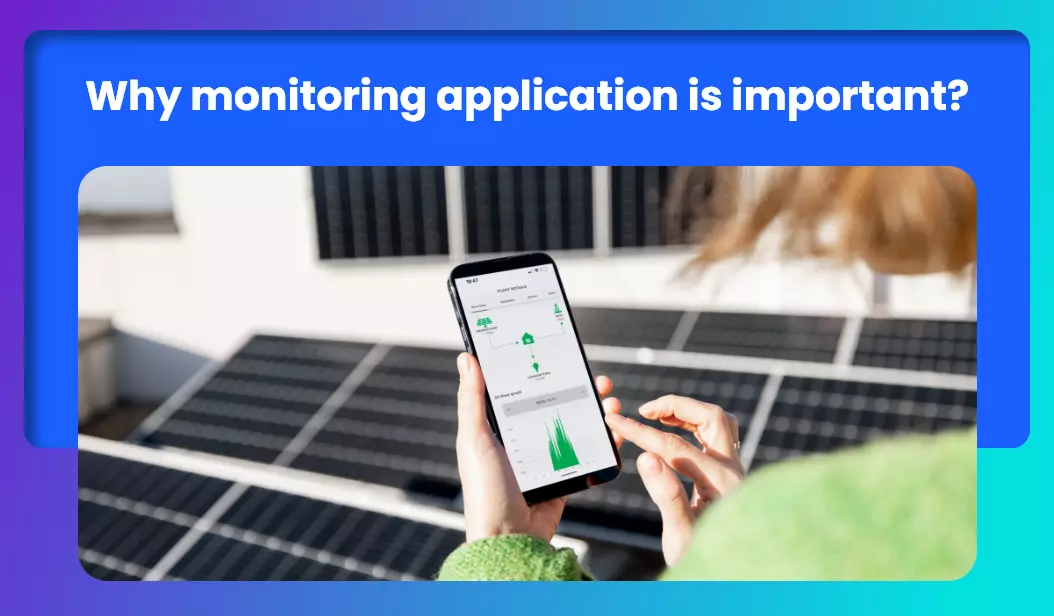Why Monitoring Applications is Important?
Monitoring application performance through metrics like response time and throughput is important for identifying underperforming software and making data-driven decisions on optimizing, upgrading, or changing SaaS apps.
In today’s business world, every organization is working with software apps. From teamwork and customer communications to payments, all business operations are running with the help of apps. To ensure the sustainable growth of business and the continued working of these apps, monitoring applications is a must to do thing.
The reliability of applications should be maximum because any disruption or error in apps supporting your business can affect your business operations. Especially if the application is related to sales, it may lower the sale, and ultimately revenue will be lower.
This article will give us insight into monitoring applications systems, their purpose usage, and different tools.
What is Monitoring Application?
Application monitoring is essential for businesses seeking to ensure effective performance and user-best experiences. It is a process of monitoring application performance, managing and analyzing areas of improvement. Using APM, organizations can access errors, resolve performance issues, reduce downtime, and increase application performance.
Effective monitoring application involves keeping track of metrics like response time, errors, resource utilization, and bandwidth. By tracking these activities continuously, businesses can identify time constraints, bottlenecks, and resource allocation.
Purpose of Monitoring Application
Application monitoring works as a strategic tool that gives insight into application performance, user experience, reliability, and accessibility.
The following is the purpose of application monitoring:
1. Analyzing and Resolving Issues
With application monitoring, IT teams can analyze troubleshooting and errors in the application performance.
This helps in maintaining excellent performance and avoids issues that can potentially affect business progress.
2. Recognizing System Dependencies
Every application has a linkage with so many other factors like servers, databases, and third-party services.
Monitoring applications gives us details that how these factors depend on each other and how they affect the performance of our application.
3. Assuring Availability
By analyzing an application’s performance, teams can understand the availability of their applications and whether their services are available to end users or not. And ensure that they enjoy a consistent availability of all the services.
4. Instructing Business Decisions
The data which is obtained from application monitoring can be used for making important business decisions on which areas they need improvement and investment decisions.
Criteria of Good Monitoring Application System
The following are the criteria to judge which is the best monitoring application system:
Easy to Use
A good system should have easy-to-use features that users can easily set it up. And users can easily track and navigate the system, view the performance reports and set up warning in case of any error.
Adaptable
Every application has different features, and their monitoring needs are also distinct from each other. The system should allow you to manage and customize monitoring functions based on your application’s unique features and business requirements.
Capabilities to Integrate
A perfect monitoring system should easily combine with other tools and systems. It could include development tools, communication platforms, ticketing systems, etc.
Warning and Reporting
The system should be like that it gives you warnings and alerts when an error occurs and also reports in detail about the issues. So you can analyze it and can take steps to prevent it.
Scalability
The best monitoring system should always have room for expandability; business needs can increase, and applications should also be increased in this scenario. As the application and user base grows, the system should be able to extend with you and handle the increase in the volume of data or new features.
Careful Monitoring
Monitoring of application performance should be a proactive process; it should alert you and warn you before any issue or error arise, not after they badly affect business operations.
Supportive in Different Environments
Some applications run not only in a specific environment, but they run in different environments like hybrid, on-premises, and cloud, so a good system should have the capability to manage and monitor all the different environments.
Security
The system should also ensure good security and protection of the application; it must have features like encryption methods and data safety.
Broker Support
Vendor support also makes a system perfect; it makes it more reliable and absolute when your vendors will support your implementation and monitoring.
Free Trials
A good system also offers a free trial before purchasing it; in this trial, you can easily evaluate the performance and features of the system. And can have an understanding of its usage and see if it will be perfect for your application or not.
Cost Saving
The price of a monitoring system should also fit in the price of the application development means it does not you extra charges and guarantee you a good return on investment.
Application Monitoring Tools
After reviewing the criteria of a good monitoring system, you can easily see which tool will be proven best for monitoring applications.
Let’s take a look at these:
i. App Optics
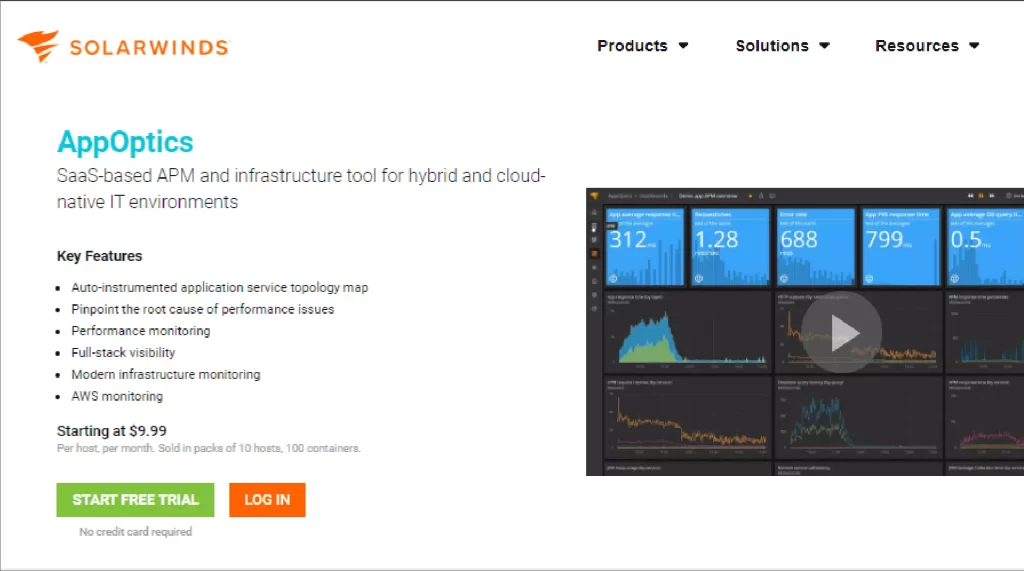
Apps Optics is a system of SolarWinds that helps monitor applications; it is the most affordable and useful monitoring tool built to rate your application and keep a record of resources used and other things to ensure the best quality user experience. A trusted APM tool supports languages like Net, Java, scala, python, node, etc.
Key Features of this Tool:
Here are some of the prominent features of this tool that make it reliable and useful:
- Performance monitoring
App optics gives details about the performance of applications which includes tracing the ability to identify errors and resolve them.
- Framework monitoring
It monitors the complete infrastructure of an application and provides insight into the database, servers, and other elements of IT.
- Cloud management and monitoring
App optics assists a wide variety of cloud services and provides an integrated view of your application and framework performance around different environments.
- Alerting and warnings
It allows its users to set up warnings and alerts based on uncertain activities, ensuring you are instantly notified when any issue arises.
- Integrity
App optics can be combined with SolarWinds products and with different third-party tools that provide a thorough monitoring solution for your IT issues.
- Reporting
It offers adaptable dashboards and reports to assist you in envisioning and understanding data and helps in trend analysis and decision-making.
ii. ManageEngine Application Manager
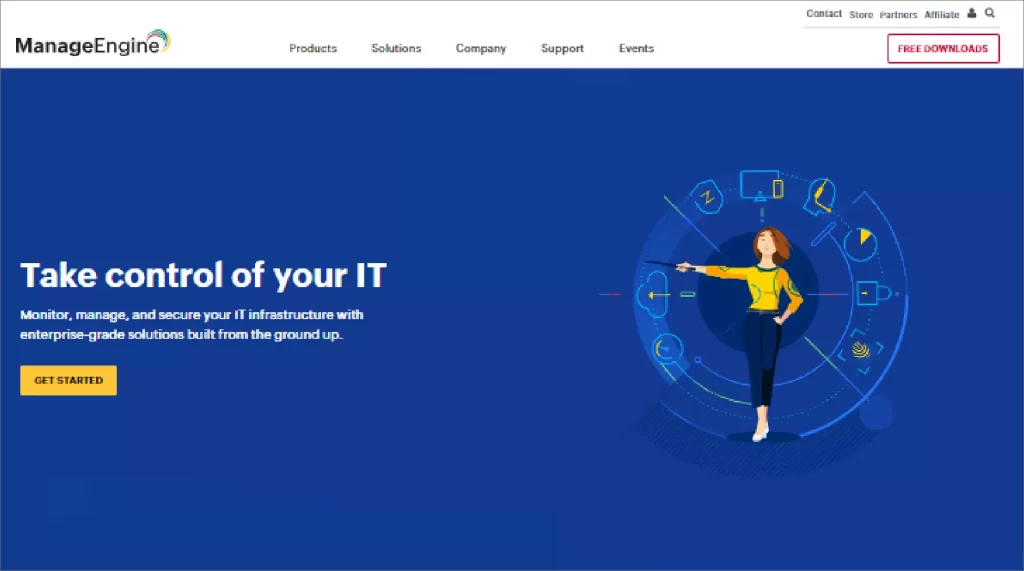
The ManageEngine application monitoring tool helps businesses to make sure their business-critical applications and servers are running smoothly at their highest performance level. It supports almost 130 applications and framework technologies, assists businesses in enhancing their application performance, and fixes issues promptly.
Key features of the ManageEngine application manager
- Monitoring of application performance
It checks the performance of an application, accessibility, and usage areas of servers and applications that include databases, ERP suites, web applications, cloud services, virtual systems, etc.
- In-depth diagnostics
ManageEngine provides an in-depth understanding of application performance, problems, and errors and helps to recognize and sort out issues promptly.
- End-user analysis
It monitors the end-user experience and provides an understanding of application performance from the end user’s point of view.
- Alerts and automated steps
Provides automated alerts with the help of notifications and takes automated steps like executing a note when monitoring parameters surpass a certain limit.
- Reporting
It provides a detailed report and visual presentation of data that helps in trend forecasting and important decision-making.
- Integrations
ManageEngine can be integrated with third-party tools and other products of ManageEngine and offers an integrated solution for IT management.
iii. Site 24*7
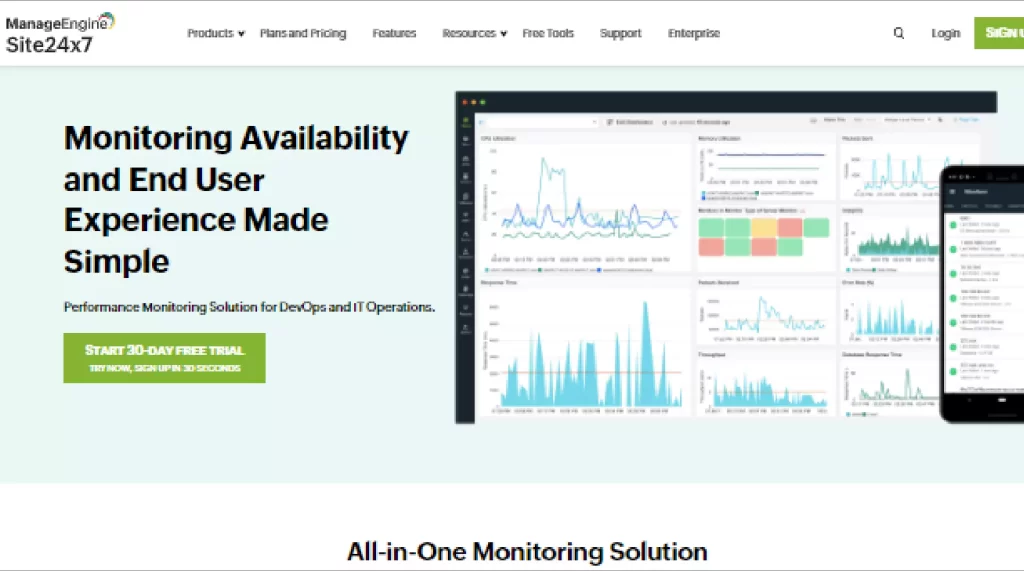
Site 24*7 is a multi-functional monitoring tool that is cloud-based. It evaluates application performance on different platforms, like PHP, Node.js, Ruby, Java, and NET. It is designed to help businesses understand that their core services are available and performing at peak levels.
Key Features
- Monitoring webpage
It makes you able to monitor your webpage at any time, its accessibility and performance, and assuring that websites are running smoothly and providing a flawless user experience.
- Monitoring application performance
This offers in-depth monitoring of applications performance to track and maximize application efficiency from server to database questions.
- Examine the server
It provides complete monitoring of the server and includes various capabilities, server types, and frameworks to guarantee availability and high performance.
- Evaluate end users
By tracking the end users’ activities on your websites and applications, it monitors the end-user experience.
- Monitoring the cloud
Provides you insights into the performance of cloud services that assists you in maintaining the highest performance and accessibility of cloud resources.
- Warning and reporting
It offers personalized alerts and reports, allowing you to stay well-informed about the system’s status and make useful decisions.
iv. Datadog
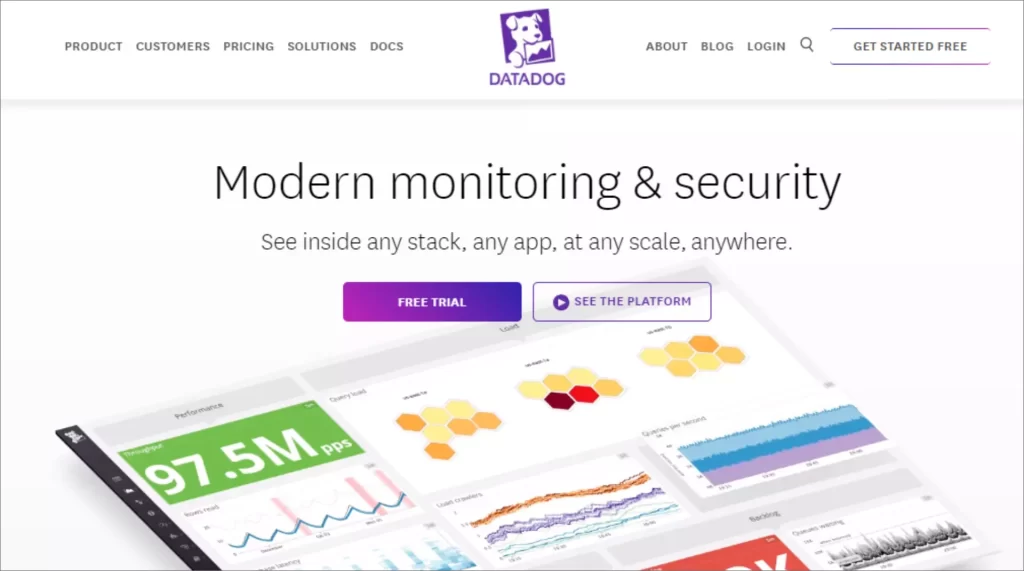
Datadog is also a cloud-based tool for application monitoring that helps to identify the primary cause of any problem in applications just in seconds. Using this tool, your organization can evaluate all your applications, framework, and event logs. It is also adaptable to hybrid, on-premises, and cloud-based systems. Also, it can detect latency issues, bottlenecks, and time-lagging issues.
Key Features
- Detailed performance
It gives you complete detail of your application performance and metrics like bandwidth, latency, and error rate for each feature or service the end user uses.
- End-to-end request tracking
Datadog allows you to trace requests as they pass through various environment services. This helps in recognizing the performance obstacles and bottlenecks and understanding the effect of individual end-user on application performance.
- Alerting
It allows you to set up alerts based on performance metrics and ensures you get notifications quickly if any problem occurs.
- Integrity
Datadog APM tool integrated smoothly with the other Datadog platform, which includes monitoring of infrastructure, artificial monitoring features, and log management, and provides a consolidated view of the complete tech stack.
- Support various infrastructure and languages
It supports various frameworks and programming languages and ensures that you examine and evaluate all components of your application.
- Tracking with flame graphs
Flame graphs show a presentation that how resources are being used by the application, helping you to examine which parts of the application are the reason for slowing down the application.
Types of APM Tools
There are 3 different types of Application Performance Management tools. Let’s take a look at these one by one:
i. Code-Profiling-Based APM Tools
It takes an in-depth assessment of your application performance by inspecting code execution in problem-solving time. They can analyze which methods in your codes are using more resources or causing performance malfunction.
This APM tool is greatly useful during an application’s development and trial stages, helping developers recognize and improve inefficient code.
After clarifying at the code level, these tools facilitate developers to identify bottlenecks where they are occurring and fix them.
ii. Application Metrics-Based APM Tools
Application metrics-based APM tools give attention to tracing and analyzing data available on application performance. These tools collect a broad range of metrics, like request rate, response time, error rate, and more, to provide a comprehensive view of the application’s performance.
They allow you to understand how your application acts under different circumstances and how the performance of the application progress over time.
By constantly monitoring metrics, you can immediately recognize any errors in functioning or problems in performance and can amend them. Operations teams utilize these tools to ensure application accessibility and maximized performance.
iii. Network-Based APM Tools
As its name suggests, it mainly focuses on networking aspects of application performance. They can analyze and recognize data traffic between the users and the application and also between different factors of the application.
These tools help to pinpoint all the network issues like packet loss, bandwidth usage, and network latency that might impact and lower your application performance.
By providing clarity of your network performance, these tools can help to make it certain that your network framework is not a bottleneck of your application performance. They are effective, particularly for distributed architectures, where application depends completely on network communication.
Final Thought - Importance of Monitoring Application
No matter what kind of business you are running, you will need application monitoring in every business to analyze application performance and fix issues. In the case of online businesses, their whole business relies on the efficiency of applications because it helps them to take orders from customers and also in delivering products to them. Therefore, it is essential to punctually improve and minimize the code errors and all other issues your application faces.
Daily, millions of people use applications to get information, purchase products and services, or make payments. So, it is important to meet the optimal level of performance in order to deliver a premium user experience. Developers of applications can get insight into performance reports and any updates.
Properly advanced and developed applications reduce the complaints calls at the help desk and increase traffic on your application. Above mentioned, APM tools can help you choose any of them according to your budget and requirements. You can also compare APM tools with each other and then choose any one.
Application monitoring is crucial because it enables businesses to detect and resolve issues in real-time. In today’s digital world, application monitoring has gained importance to assess performance, minimize downtime, and prevent disruptions, ultimately improving user satisfaction and business success.
Monitoring applications offer several benefits for business growth and increased capacity. It helps prevent downtime, optimize resource utilization, and ensure data security. It guarantees that your applications run smoothly and efficiently and deliver a seamless user experience.
Monitoring applications improves user experience by minimizing disruptions and ensuring applications run smoothly. Users can access and interact with the application without downtime or performance issues, increasing satisfaction and trust in your services.
Yes, application monitoring can save business costs by ensuring effective resource allocation, preventing resource over-utilization, and optimizing resource use. These steps may help reduce operational costs, making your business more efficient, profitable, and competitive in the long run.
Yes, application monitoring is essential for businesses of all sizes, regardless of their size. It helps build credibility, prevent issues, and remain competitive. Since avoiding downtime and performance issues is even more crucial for small businesses than larger businesses, monitoring applications may help small businesses enormously.
